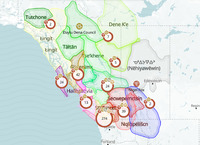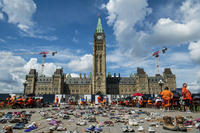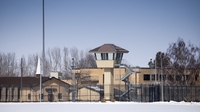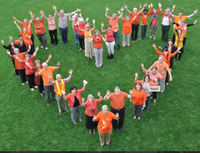Community, Nation, Memory
During this week, the class explored the connection between community, nation, and memory. Still working with excerpts from Olick et al's Collective Memory Reader, we considered a short piece from Bellah, Madsen, Sullivan, Swidler, and Tipton's classic Habits of the Heart where they introduce the term "community of memory." A selection from Anthony Smith's The Ethnic Origin of Nations encouraged us to think about why people seek a relationship to the past, and how they do this through the construction of nationial memories. Yael Zerubavel's Recovered Roots offered many insights into the narrative construction of communal and national memories, and a wealth of new concepts. Given the heavy narrative and linguistic focus of the first readings we also read from phenomenologist Edward Casey's Remembering which focuses on embodiment and commemoration.
It is telling that, independent of each other, several of this week's contributors introduced images related to Canada's colonial history, the harms done to Indigenous peoples, through institutions such as residential schools, and the cultural traditions that provide solidarity. They emphasize processes by which memory is destroyed, but also how "countermemories" produced or recovered.
Additional resources can be found at the webpage for the Truth and Reconciliation Commission of Canada, which includes the Final Report of the Truth and Reconciliation Commission. MacEwan's kihew waciston Indigenous Center also has information about how the National Day of Truth and Reconciliation has been marked at MacEwan.
This above image is a still from the First Peoples' Cultural Council's interactive, community contributed map project. This project intends to revitalize B.C.'s Indigenous langauges and culture through active participation from members in these communities. I was introduced to the idea of "dying languages" in a linguistic anthropology class. Under colonialism, many First Nations communities faced forced erasure of their culture and spoken languages.
Anthony Smith describes nations as a product of memory dialogue between dominant institutions and social groups; but what happens when the dominant groups attempt to erase marginalized ones? A concept that permeates through the readings for this week is commemoration and its importance in revitalizing memory and community. If we do not actively commemorate a shared memory, it risks becoming a dead memory.
This map project is an example of what Edward Casey describes as "commemorabilia" (Olick et al., 2011) because it is a physical medium that we engage in to remember and honour these communities. It also exemplifies the idea that collective memory is an active process that is changing and reshaping from the narratives of those in the social group. Bellah et al. hightlight the pain and shared suffering of communities as just as vital to commemoration as the good stories, and this pain is ingrained in Canada's history of colonialism. (Contributed by J.V.)
Suffering Inflicted-Dangerous Memories of a Community
The photo that I have chosen is of children's shoes on government buildings. These shoes on the government building represent the lives lost of Indigenous children through the years of residential school and the recent findings of unmarked graves. These shoes represent the acknowledgement of the horrible and terrifying treatment of children that was inflicted on Indigenous children for simply being Indigenous and the need to continue to search for more unmarked graves. A quote from the essay Habits of the Heart I think best illustrates this event that happened in Canada and the response and support that was had to continue to find unmarked graves and bring these children recognition and acknowledgement.
“A genuine community of memory will also tell the painful stories of shared suffering to sometimes create deeper identity than success…. And if the community is completely honest, it will remember stories not only of suffering received but of suffering inflicted- dangerous memories, for they call the community to alter ancient evil,”(Bellah et al's, 229).
Growing up through school I always remember learning about the residential schools in Candian history, I remember having friends who were Indigenous and seeing the suffering their families had from the lasting effects of residential schools. When the unmarked graves were found and some Canadians and Indigenous persons were putting children's shoes on government buildings it created a very powerful stance of acknowledging what happened in the past of the community and using this event to be better in the future. I think one of the first steps to being better as a community was creating the National Day of Truth and Reconciliation. Submitted by GK.
Shared memory of Incarcerated Persons
When I heard the statement "Community of memory," it made me think of the clients I work with. A large part of my job is just listening. They have all been in a federal institution for a minimum of 2 years, and as a result, they were in a situation where they were completely isolated from all communities. So they have not only been isolated from their past, their culture, and their traditions in a physical sense, but they have also been isolated psychologically and alienated from their memories. This pushes them away from their past groups (family/ religion/culture), as well as the nation in which they live.
Smith states, "Alternatively, modern societies are regarded as peculiarly liable to anomie: rapid change deregulates our lives and throws our passions out of line with our opportunities. Hence, the urgent need for antidotes, which will reintegrate and re-root us in a satisfying social framework, one that preserves liberty and individuality while anchoring both in social justice and solidarity. This means, in turn, linking a mode type of society and social order with collective traditions and native habitats: in other words, with a group's history and homeland." (Smith in Olick et al: 232) People who feel alienated and separated from their culture and identity are then labeled as being criminal. This form of alienation leads to the development of new narratives, and forms bonds between people within correctional institutions; a community, with their own culture and expectations.
"All that is left is memory and hope, history and destiny. But these memories and hopes are collective and inter-generational; they are 'our' history and 'our' destiny." (Smith in Olick et al: 234) Many clients have a sacred connection to their pasts. However, these individuals are isolated from their communities. The link to their pasts leads them to practice their religions, create traditional artwork, and tell stories from their pasts. However, many of them suffer from the consequences of becoming institutionalized. Many express a similar notion that they do not want to change to fit into the social norms of a nation that did not see them as worth helping. Many of them have been in the system since they were kids and share the traumatic memories of abuse as children or growing up in foster care. As a result, they may go back to the communities they know will accept them and share those memories of suffering. (contributed by HS)
"Every Child Matters"
During our study of this week's topic - Memory, Community, and Nation, Yael Zerubavel's essay stood out to me. It discusses the importance of a commemorative narrative in collective memory for a nation or group. I find her viewpoint fascinating, as I believe one must question everything. This is true for our memories and the collective memories with our group. Zerubavel emphasizes the vital role of a master commemorative narrative in a culturally constructed storyline that gives group members a shared past. She also discusses the term countermemory.
Zerubavel says on page 241:"The master commemorative narrative represents the political elite's construction of the past, which serves its particular interests and promotes its political agenda. Countermemory challenges this hegemony by offering a divergent commemorative narrative representing the views of marginalised individuals or groups within the society."
When I was a new student at MacEwan, I remember feeling cheated, angry and confused when I first learned of the brutal nature of residential schools and the alarming aspects of colonialism. Going through school from K-12, I remember seeing photos of students before arriving and after arriving at a residential school, group photos of students, and learning about different cultural practices. At no point in my public or private education was I ever informed of what we now know as an act of genocide. How could educators, government, and political leaders leave something this crucial out?
I chose this picture of an individual wearing this shirt because I believe that the social movement that is Orange Shirt Day is an excellent example of countermemory as it commemorates a narrative to support Residential School Reconciliation, raising awareness of intergenerational trauma caused by Residential Schools, and creating awareness of the concept “Every Child Matters" -Submitted by KC



